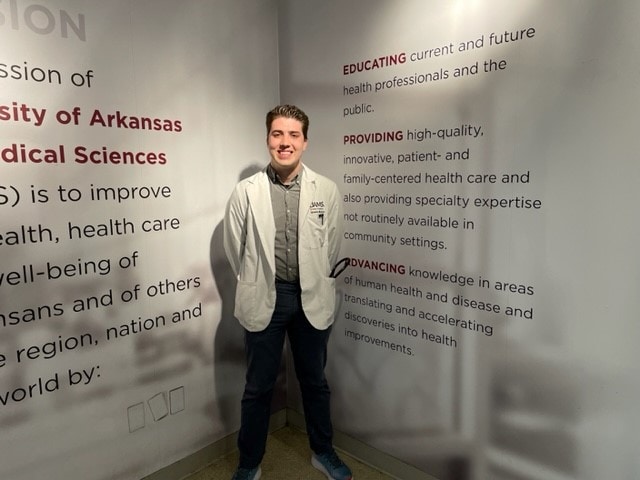Medical Student’s Two-Year Detour through NIH Reinforces Chosen Career Path
| | Two years after taking a break from medical school at the University of Arkansas for Medical Sciences (UAMS) to participate in the prestigious Medical Research Scholars Program (MSRP) at the National Institutes of Health (NIH), Mason Belue is more excited than ever about their future as a clinician-scientist.
Instead of being away from UAMS for just one year, as initially planned, Belue, who uses the pronoun they, stayed in Bethesda, Maryland, for a second year to complete a second fellowship.
Even though it pushed Belue’s anticipated graduation date, once set for this spring, to 2025, the delay isn’t a problem, the third-year student said recently after resuming medical school at UAMS because “I had one of the best experiences I could ever have.”
Belue was one of 50 students nationwide selected in 2021 to participate in the MSRP, a yearlong residential immersion program at the NIH headquarters in Bethesda. It was only the second time in a decade that a UAMS student had been accepted into the prestigious, highly competitive program. It serves as a fellowship and enables students to conduct basic, translational, or clinical research in NIH laboratories and patient care areas.
“My ultimate career goal is being a clinician-scientist at the NIH, the largest hospital fully dedicated to research in the world,” Belue said two years ago. “It’s exhilarating to have that as my career goal and to get my foot in the door.”
Although Belue originally planned for just a one-year absence from medical school, they received the Cancer Research Training Award from the National Cancer Institute (NCI). This second fellowship opportunity allowed them to continue living for another year in the “Cloisters,” a former convent on the NIH campus, surrounded by like-minded colleagues and the nation’s top physician-scientists — some of whom became mentors.
Belue said both fellowships were “fantastic” and reinforced their desire to be both a clinician and a researcher while helping narrow their focus in the direction of radiology.
Belue said in 2021 that clinician-scientists who see patients and use their experiences to inform research are “right in the middle of scientific discovery” — something they truly came to understand during their time at the NIH.
“We participated in a lot of research, but we also got experience directly applying that research to our patients,” they said, referring to themself and other fellows.
Belue was involved in multiple clinical trials, including characterizing the natural progression of prostate cancer and identifying signs in different racial groups. Their primary research mentors were Baris Turkbey, M.D., and Peter Choyke, M.D., who currently lead the NCI molecular imaging effort. This exposure enabled Belue to see several patients with rare presentations and genetic mutations that increased their risk of prostate cancer — something rare outside the NIH setting, where every patient is part of a clinical trial. Many have the most infrequent and most complicated disorders.
Belue also spent a lot of time working with artificial intelligence (AI) algorithms — a longtime source of fascination.
They were impressed to see how AI provided a three-dimensional view of cancerous lesions, making it possible for researchers to precisely determine how much a patient’s lesions had grown in diameter and volume since an earlier visit to gauge whether the patient was responding well to a particular treatment.
Belue applied the techniques they learned during the prostate cancer AI development to other clinical trials within the NCI that evaluated brain cancer’s responsiveness to chemotherapeutics and observed how AI enables researchers to find and characterize cancers that even experienced radiologists sometimes can’t.
“It was incredible learning from the pioneers in the field,” they said.
Belue was thrilled to attend lectures given by renowned physician-scientists, including Anthony Fauci, M.D., former director of the National Institute for Allergy and Infectious Diseases and adviser to seven presidents; and Francis Collins, M.D., Ph.D., a physician-geneticist who discovered the genes associated with such diseases as cystic fibrosis, neurofibromatosis and Huntington’s disease and led the Human Genome Project, becoming known as the first person to decode DNA.
Belue was a presenter last year at the annual meeting of the Radiological Society of North America, the world’s leading radiology forum, and has been invited back to give multiple presentations at this year’s convention, to be held in late November in Chicago.
During their time in Maryland, Belue published 11 peer-reviewed manuscripts, some as the primary author, in some of the best academic journals for radiology.
“I had time to hunker down,” they said. “I now have a much deeper appreciation for research.”
“The NIH Medical Research Scholars Program attracts the brightest talent from across the country,” Thomas R. Burklow, M.D., director of the program, said in 2021. “These scholars are the future leaders in American medicine.”
Belue said they plan to apply for a residency in radiology after obtaining their medical degree, though where they might go is “up in the air.”
“I would love to end up at an academic hospital,” they said. “Really, what makes the difference is having great mentors. NIH has all that, and so does UAMS.”
Before medical school, Belue earned their undergraduate degree in biomedical engineering from the University of Arkansas at Fayetteville.
